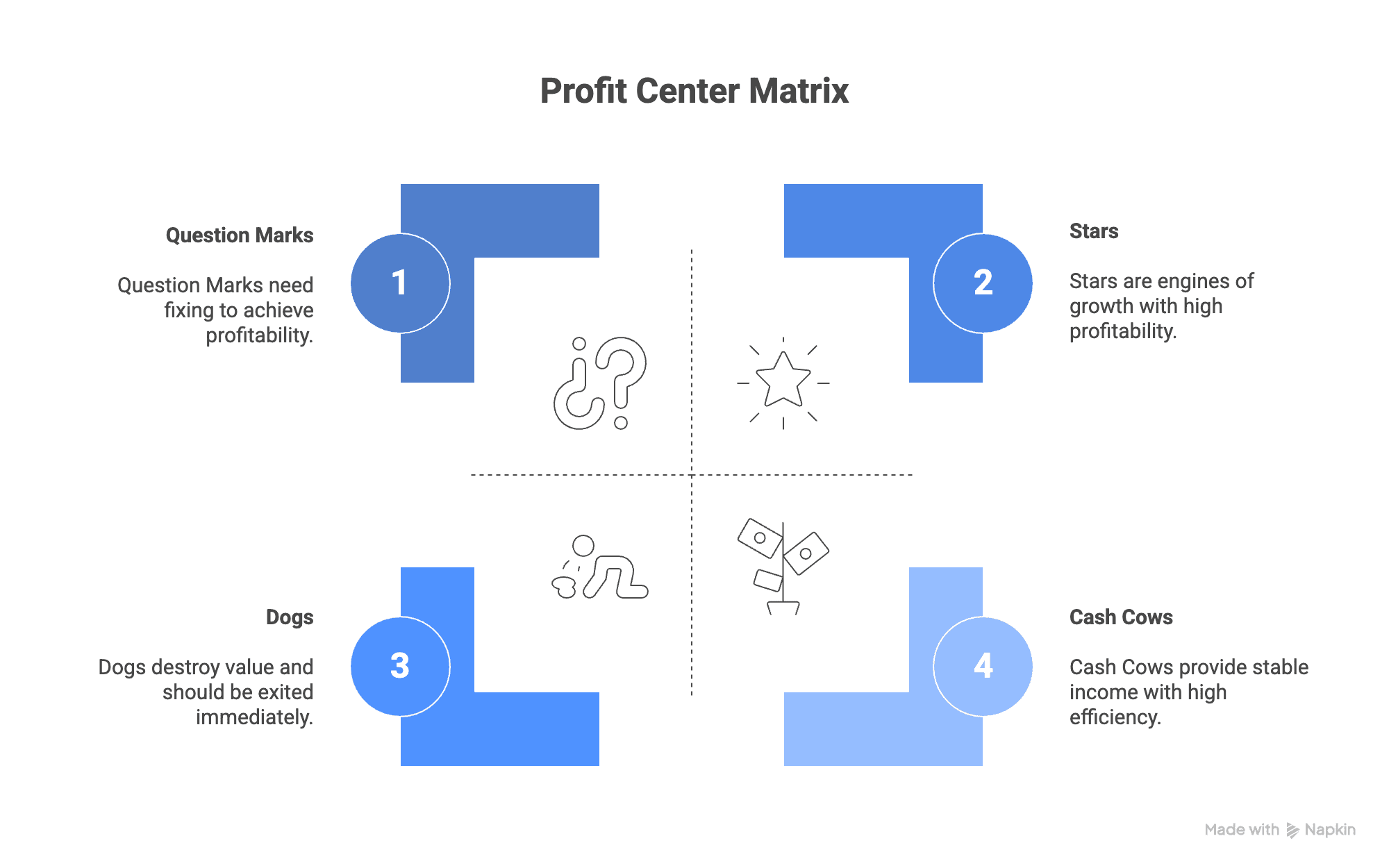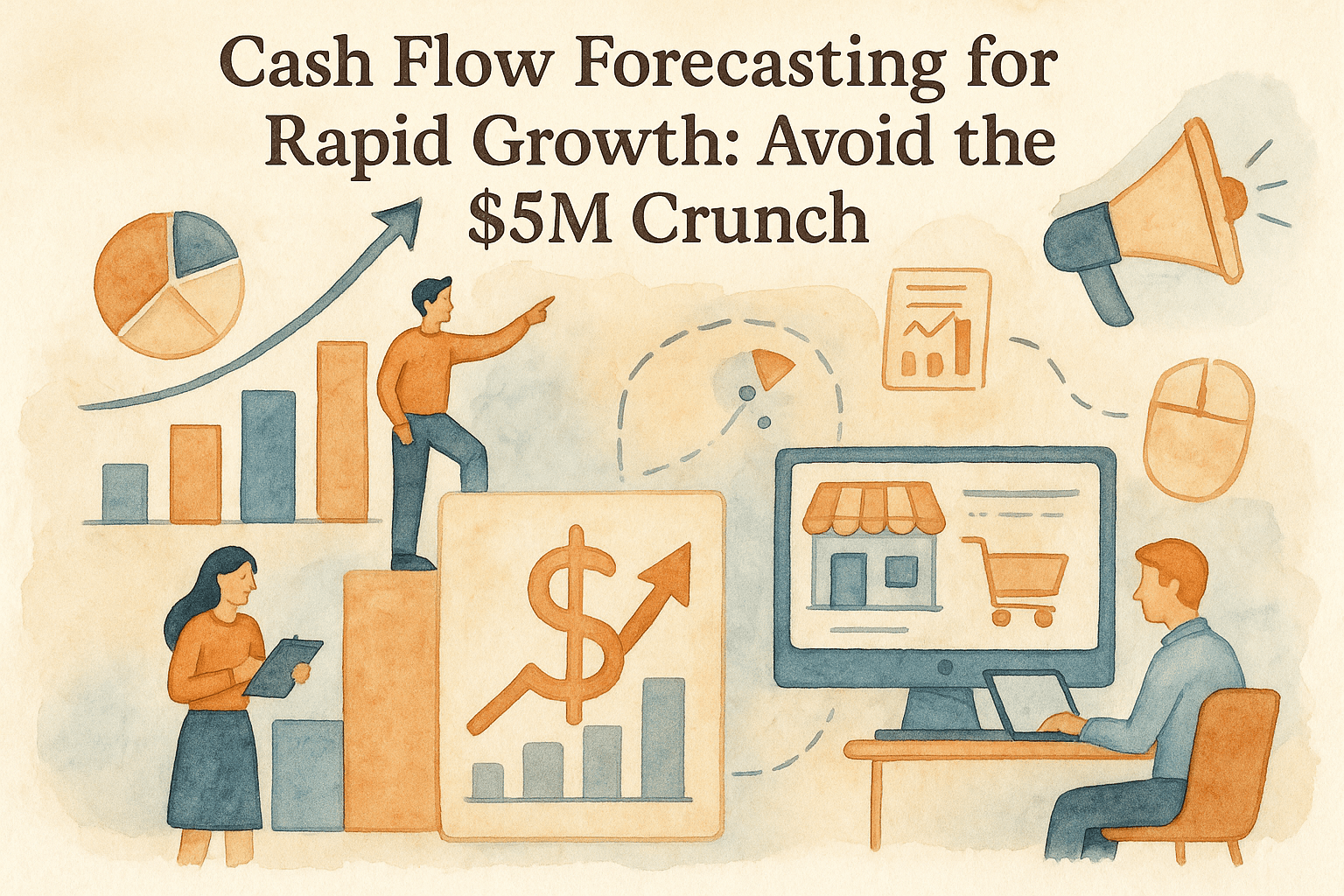Why Your "Profit Centers" Are Actually Subsidizing Your Losses
Updated:
November 2, 2025
7 min read
Why Your "Profit Centers" Are Actually Subsidizing Your Losses
Most eCommerce businesses operate with a dangerous illusion: they believe certain product lines or channels are profitable because the aggregate P&L shows black ink. In reality, their best-performing segments are subsidizing disasters they can't see.
The typical approach to profit center analysis-quarterly revenue reviews, gross margin reports, departmental budgets-was designed for stable manufacturing businesses. Apply it to dynamic eCommerce operations, and you'll systematically misallocate resources for years before the damage becomes visible.
Profit centers provide a framework for aligning diverse business units under a shared corporate mission. But that framework only creates value when the boundaries are drawn correctly and the allocations are honest. Neither condition is typically met.
The Cost Allocation Catastrophe
Here's how cost allocation fails in eCommerce:
Scenario: A brand sells two product categories-skincare ($1M annual revenue, 65% gross margin) and supplements ($500K annual revenue, 45% gross margin). The skincare line appears twice as profitable.
Reality: When you properly allocate:
Customer service costs (supplements require 3x more support calls per order)
Return processing (skincare has 8% returns vs. supplements at 3%)
Inventory carrying costs (supplements turn 12x annually vs. skincare at 4x)
Marketing attribution (60% of marketing drives skincare awareness that converts to supplement purchases)
The supplement line becomes the actual profit engine, subsidizing the skincare line's operational inefficiencies.
This isn't hypothetical. Variable expenses typically represent 40-45% of total expenditures in product organizations. Misallocating those variable expenses corrupts every downstream decision.
The Profit Center Optimization (PCO) Protocol
The PCO Protocol restructures how eCommerce businesses define, measure, and optimize profit centers. It's built on three principles:
Principle 1: Activity-Based Boundaries
Don't define profit centers by product category or channel alone. Define them by the activities that drive their economics.
Traditional boundaries:
Skincare division
Supplements division
Amazon channel
DTC channel
Activity-based boundaries:
High-touch customer acquisition unit
Self-service customer acquisition unit
Complex fulfillment operations
Simple fulfillment operations
Subscription revenue unit
One-time purchase unit
Activity-based boundaries reveal operational efficiency-or inefficiency-that category-based analysis obscures.
Principle 2: True Cost Absorption
Every profit center must absorb the costs it creates, including:
Direct costs: COGS, packaging, shipping specific to that unit's products
Allocated costs: Customer service time, return processing, inventory carrying costs-allocated by actual usage, not revenue percentage
Shared costs: Technology, overhead, management-allocated by driver (orders processed, SKUs managed, hours consumed)
Cost centers are evaluated based on their ability to control costs, optimize resource utilization, and achieve budgeted targets. But profit centers must absorb the cost center expenses they generate. Without this absorption, profit center analysis becomes fiction.
Principle 3: Contribution Stacking
Measure profit centers at multiple contribution levels:
Contribution Margin 1: Revenue - COGS
Contribution Margin 2: CM1 - Direct Operating Costs
Contribution Margin 3: CM2 - Allocated Operating Costs
Contribution Margin 4: CM3 - Share of Fixed Costs
A profit center might show 60% CM1 but only 8% CM4. That 52-point spread reveals where operational complexity destroys value.
The Four-Quadrant Profit Center Matrix
Plot each profit center on two axes:

X-Axis: Contribution Margin 4 (fully-loaded profitability) Y-Axis: Year-over-Year Growth Rate
This creates four quadrants:
Quadrant 1: Stars (High CM4, High Growth) Action: Invest aggressively. These are your engines.
Quadrant 2: Cash Cows (High CM4, Low Growth) Action: Maintain efficiency, harvest cash for Star investment.
Quadrant 3: Question Marks (Low CM4, High Growth) Action: Fix unit economics or kill within 6 months. Growth without profit is destruction.
Quadrant 4: Dogs (Low CM4, Low Growth) Action: Exit immediately. Every day of operation destroys shareholder value.
Most eCommerce businesses have 40-60% of their SKUs in Quadrant 4 and don't know it. They're running a charity for customers who buy their least profitable products.
The Hidden Profit Center: Operations
Operations isn't a cost center-it's a profit center in disguise.
Consider two scenarios:
Scenario A: Operations runs at industry-standard efficiency
Pick/pack cost: $2.50/order
Shipping cost optimization: None
Return processing: 5 days average
Scenario B: Operations optimized
Pick/pack cost: $1.75/order (30% reduction through layout optimization)
Shipping cost optimization: 15% reduction through carrier negotiation and packaging redesign
Return processing: 2 days average (enabling faster inventory recovery)
On 100,000 annual orders with $50 AOV:
Scenario A Operations Cost: ~$400,000
Scenario B Operations Cost: ~$280,000
Annual Savings: $120,000
That $120,000 flows directly to bottom line. Operations, when optimized, becomes a profit center generating returns that rival your best product lines.
To reduce costs and drive up profits, what the cost center must do is work towards greater operational efficiency. But you won't invest in operational efficiency unless you measure it as a profit center.
The Revenue vs. Profit Reframe
Stop celebrating revenue. Revenue is vanity. Profit is sanity. Cash is reality.
A $10M revenue business with 5% net margin generates $500,000. A $5M revenue business with 15% net margin generates $750,000.
The smaller business is worth more. Yet eCommerce culture celebrates the $10M business because bigger numbers feel better.
The PCO Protocol requires a mental model shift:
Old Model: Maximize revenue, manage costs New Model: Maximize contribution margin per resource deployed
This reframe changes everything:
You stop chasing low-margin volume
You start investing in operational efficiency
You exit customers and products that don't earn their keep
You build a business worth owning, not just running
Implementing PCO: The 90-Day Transformation
Days 1-30: The Profit Center Audit
Week 1: Define profit center boundaries using activity-based logic Week 2: Map all costs to profit centers (direct, allocated, shared) Week 3: Calculate CM1-CM4 for each profit center Week 4: Build the four-quadrant matrix
Days 31-60: Strategic Reallocation
Week 5: Identify Quadrant 4 (Dog) profit centers for immediate exit Week 6: Develop improvement plans for Quadrant 3 (Question Mark) centers Week 7: Create investment plans for Quadrant 1 (Star) centers Week 8: Optimize Quadrant 2 (Cash Cow) centers for maximum harvest
Days 61-90: Operational Transformation
Week 9: Implement exit plans for Dogs Week 10: Launch improvement initiatives for Question Marks Week 11: Deploy capital to Stars Week 12: Establish monthly PCO review cadence
The Profit Center Scorecard
Track each profit center against these metrics monthly:
Metric | Target | Weight |
|---|---|---|
Contribution Margin 4 | >15% | 30% |
YoY Growth Rate | >10% | 20% |
Return Rate | <15% | 15% |
Customer Service Cost/Order | <$2 | 10% |
Inventory Turns | >6x | 15% |
CAC Payback | <6 months | 10% |
Composite score determines investment priority. Profit centers scoring below 60 receive no incremental investment. Profit centers scoring above 80 receive priority capital allocation.
The Uncomfortable Decisions
The PCO Protocol will surface decisions you've been avoiding:
"Our best-selling product isn't profitable." Exit it. Brand recognition built on losses isn't an asset.
"Our largest customer segment destroys margin." Fire those customers. Raise prices. Change product mix. Do something.
"Our Amazon channel subsidizes our DTC channel." Either fix DTC economics or acknowledge that Amazon is your business and DTC is a hobby.
"Our team is organized around products, not profit centers." Reorganize. Alignment to profit centers creates accountability.
Profit centers focus on maximizing revenue and optimizing costs to generate profits. They have clear financial targets and often have the autonomy to make strategic decisions regarding pricing, marketing, and resource allocation to achieve their financial goals. Without clear boundaries and honest measurement, that autonomy becomes organizational chaos.
The North Star: Return on Invested Capital (ROIC)
The ultimate profit center metric isn't margin-it's return on the capital deployed to that center.
ROIC = Net Operating Profit After Tax / Invested Capital
For eCommerce profit centers, invested capital includes:
Inventory allocated to that center
Equipment and technology supporting that center
Working capital tied to that center's operations
A profit center with 20% CM4 but requiring $2M in inventory generates different returns than one with 15% CM4 requiring $500K in inventory.
Target ROIC by growth stage:
Early stage (<$2M revenue): 15%+ acceptable
Growth stage ($2-10M): 20%+ expected
Mature stage ($10M+): 25%+ required
Profit centers below ROIC threshold should be candidates for divestiture or restructuring, regardless of their contribution margin.
Stop managing profit centers by gut feel. Start managing them by ROIC. That's how real investors think-and it's how you should think about your own business.



